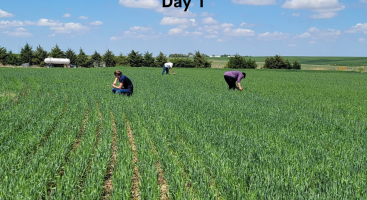The U.S. Department of Agriculture’s Acreage Report sent corn and soybean prices in opposite directions, economists said.
The report, issued Friday, saw corn acreage in the U.S. rise 3.4% from February estimates, while soybean acres fell 4.6%. At 94 million acres, this year’s corn crop is the third largest since 1944. Soybeans were down to 83.5 million acres.
Rice and cotton also gained ground, the report said, with rice up 7.5% from February’s estimates and cotton up 1.7% to 11.1 million acres in June.
After the report, prices rose for soybeans and sank for corn.
“There were some unexpected changes in harvest-month futures prices Friday after that report came out,” Hunter Biram, extension economist for the University of Arkansas System Division of Agriculture, said. Looking at the Chicago Mercantile Exchange price history, “you’ll just see a straight line—down in the case of corn because of higher production expectations or shooting straight up” for soybeans because of the fewer acres.
“December corn futures decreased by 31 cents to $5.06, while November soybean futures increased nearly 60 cents to $13.51 per bushel immediately after the release of the June acreage report,” Biram said. “Currently, December corn is sitting at sub-$5 and soybeans remaining constant around $13.50 per bushel. All that’s to say soybean prices are looking relatively better than they were prior to the report; corn prices not looking as good.”
Crop event scare
“Recent upticks in the prices of both commodities leading up to the June report have been driven by drought throughout major crop-producing states, causing a ‘crop scare event’,” Biram said. “During this crop scare, the drought impacted supply expectations which caused market and futures prices to increase.”
“The big scare had us asking if we will have the rain to meet those yield expectations,” Biram said. “And for a couple of weeks, there was a big concern that we weren’t going to be there.”
Biram said prices peaked on June 21. A week later, a massive storm system raked the upper Midwest, bringing rain, but also a destructive derecho that knocked out power to about a half-million people. Additional rain—flooding rain—hit parts of the Midwest over the weekend.
“A lot of those fears that the yield wasn’t going to meet expectation have been washed away to some degree,” he said Monday. “That’s good news in terms of production and bad news in terms of prices.”
“The large increase in corn acreage in the June acreage report will make the corn market price less susceptible to future supply shocks, causing a lower but more stable price environment,” Biram said. “However, the opposite may hold true for soybeans which have dropped 4 million acres.
“As there are fewer soybean acres than previously projected, soybean prices could be more susceptible to further detrimental weather, which causes deterioration in crop conditions and expected yield,” he said.
Arkansas numbers
Arkansas acres followed the national trend.
In Arkansas, corn acreages were estimated at 890,000, up 80,000 from the March Planting Intentions report. It’s also higher than the year-ago acreage of 180,000. Soybeans were estimated at 2.9 million acres, down 280,000 from a year ago and 150,000 less than the March estimates.
Cotton was down 160,000 acres from a year ago, but up 80,000 acres from March to 890,000.
Peanuts were up 2,000 acres to 35,000 compared to a year ago, and unchanged from the March estimates. Rice was estimated at 1.31 million acres, up 205,000 from a year ago and 10,000 acres more than the March Planting Intentions signaled. Winter wheat saw 230,000 planted acres, up 10,000 from a year ago and unchanged from March, the report said.




